
After careful research to get all of the details "just so," and many long hours of intricate designing, sewing, and fitting, I am proud to show off my latest creation...!
It is traditional scale.
(This piece was commissioned by, and is owned by Ashley Slack Waller, and is not available for sale.)

"The Winged Horsemen"
Polish Hussar
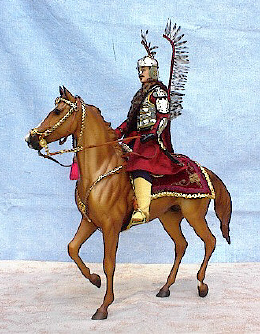
The hussar concept began in Serbia, near the end of the 14th century. At that time, they were foreign mercenaries called "Racowie," a word meaning "of Serbia." (referring to the Serbian state of Ras.)
Throughout the years, the Polish hussars, nicknamed the Winged Horsemen, gained respect as one of the finest armies in the 16th and 17th century world. Their unique lance type and superior horsemenship allowed them to achieve famous victories over armies of greater strength.
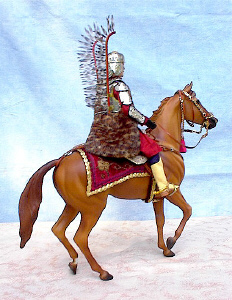
Hussar soldiers were recruited from among the Polish gentry, who owed military service to their nation in return for their titles. They were required to provide their own horses, arms, and retainers...as well as to be accomplished horsemen and fighters. Families of the gentry either trained their sons themselves, or hired ex-soldiers to train the future hussars.
Early Polish hussars dressed in Hungarian style, complete with Hungarian style fur cap (a magierka) and no defensive armor. By the 17th, the Polish hussar's costume had become a unique style of dress. Since each man provided his own clothing, costumes were as elaborate as could be afforded to show measure of wealth.
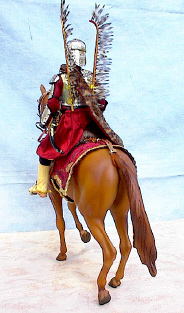
The most common fabrics for a nobleman to wear were silks, satins, and velvets. These were worked in gold with elaborate ornate embroidery patterns taken from Turkish, Persian, and Hungarian styles. Men of lesser rank wore less elaborate costumes. A few unfortunate soldiers even fought with no armor at all, causing some confusion between them and the Tartars.
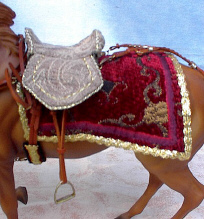
Animal skins were also part of the hussar's gear. Usually worn in the fashion of a cape or cloak, over the armor. Leopard, tiger, lion, bear, and wolf pelts were used.
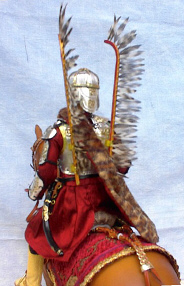
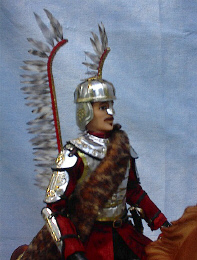

The famous wings of the hussar soldier are also of Serbian origin. It was first thought that the wings were an invention to defend the backs of the men against swords and lassos, but it is currently thought that the wings were used primarily as a means of intimidation. The noise of the wind rushing through the feathers, and the sight of the larger-than-life apparition on horseback, would cause a chaos of terror in the enemy's horses, and men. The wings were mounted on a brass-edged frame which was arched at the top, and inserted with feathers. The frame was then mounted with brackets or hinges either to the backof the soldier's armor, or, in some cases, to the back of the saddle. A pair of wings was usually used, but a single wing was also seen on occasion.
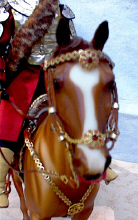
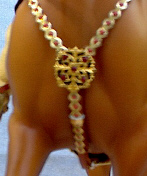

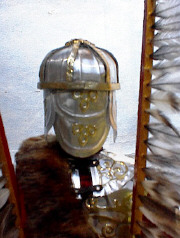
The horses of the Polish hussar were the most valuable item of the soldier, costing five to ten times as much as the rider's salary. Polish horses were well breed for speed and endurance, and were among the finest in Europe. They were not permitted to be sold outside of Poland.
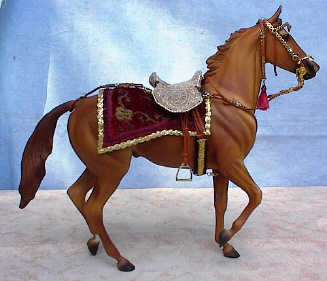
The main weapon of the hussar was the eastern lance, "Kopia." Lances measured 4.5 to 5 meters in length and were made of light elastic wood. Metal spearheads and a two-colored (red and white, usually) pennant were anchored at the tip. These lances were lighter and longer than the weapons of other armies, and could cut through thick infantry, as well as cavalry. Since the lance was so light, it was usually broken after the initial charge and then the soldier used his saber. A pair of pistols was also sometimes carried in holsters slung across the saddle, but reloading was not usually possible during battle.


HUSSAR REFERENCE PICTURES



Visitors since November 1, 2001:

![]()













![]()
![]()